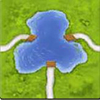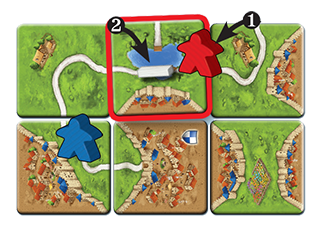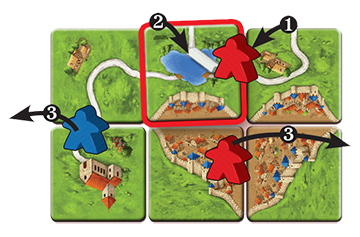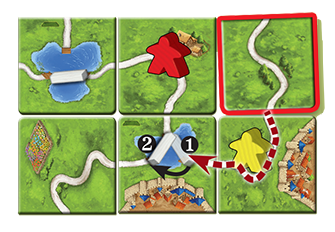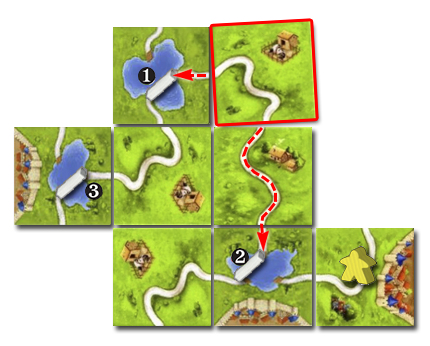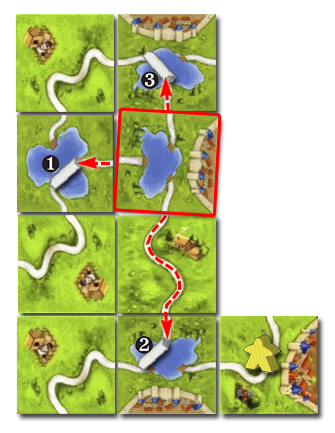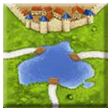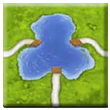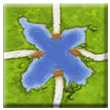Difference between revisions of "The Ferries/fr"
Black Bear (talk | contribs) |
Black Bear (talk | contribs) (Created page with "== Ensemble des tuiles ==") |
||
| Line 134: | Line 134: | ||
</ref> | </ref> | ||
== | == Ensemble des tuiles == | ||
'''Total Tiles: 8''' | '''Total Tiles: 8''' | ||
Revision as of 08:51, 3 May 2020
Informations générales et commentaires
Les Bacs (Mini #3) a été commercialisé pour la seconde édition par Hans im Glück en Template:Year fr, regroupé au sein de la Big Box 6.
Quelques routes autour de Carcassonne mènent à de petits lacs, sur lesquels naviguent des bacs. Les bacs relient les routes d’une façon ou d’une autre. Un nouveau défi à relever pour les brigands !
Matériel
- 8 tuiles Terrain avec un Lac
- 8 bacs en bois
Règles
Preparation
Shuffle the new landscape tiles with those of the basic game and stack them normally. Place the ferries within easy reach of all players.
1. Placing a tile
When a player draws a tile with a lake, he or she plays it according to normal rules.
2. Placing a meeple and a ferry [1]
You may now place a meeple on the lake tile according to the usual rules. If you choose to do it on a road, you must place the meeple on one of the 3 or 4 road ends on the lake tile. Then take a wooden ferry from the supply and place it on the lake so that it goes from one jetty at a road end to another. [2] [3] The ferry will now connect the ends of the road via the two jetties to form a continuous road. A jetty without ferry ends a road.
3. Scoring a feature
When you place a tile with a lake on it, if you complete one or more features, these features are scored normally.
Final scoring
At the end of the game, normal scoring for incomplete features applies.
After a ferry is placed, its position on its lake can change during the game:
1. Extending a road with a ferry on it [4]
Extending a road with ferries and repositioning ferries
If you use a tile to extend an open road leading to a ferry, you may now (if necessary after placing a meeple) reposition this ferry on its tile. [5] You must connect two road ends (ending at a jetty) again. You may also move the ferry so that it no longer has a connection to the road you just extended. Starting from the tile you have placed, you may only move the first ferry along the road. [6]
Special case: If the tile just placed extends several roads leading to a ferry, you may reposition the first ferry on each of these roads.
By repositioning ferries, it is possible for a road that was previously completed and scored to now be incomplete. [7]
More rules: You may only reposition a ferry only once per turn. If you place a lake tile on a road with a ferry, you first place your meeple, then you place a new wooden ferry, and finally you can also reposition one or (possibly) several ferries on the roads just extended, if any.
Additional clarifications
If roads from the placed landscape tile extend in several directions, the first ferry in each of these directions may be moved. Thus up to 4 ferries could be moved.
The following diagrams explain the movement of multiple ferries after placing a tile. Figures based on the original ones posted on BGG by Christof Tisch.
Sequence summary
When playing The Ferries, the turn sequence is now as follows:
- 1. Place a Tile
- 2. Place Meeple
- 3. Place a Ferry
- 4. Move a Ferry
- 5. Score a Feature
Other expansions
- Inns and Cathedrals: the lakes in Inns and Cathedrals do not interact with the lakes of The Ferries. Roads that have a ferry but no inn are still only worth 1 point per tile.
- Traders and Builders: Repositioning a ferry to extend a road that your builder occupies does not grant you a double turn; you must actually place a new tile on that road in order to receive the double turn. [8]
Ensemble des tuiles
Total Tiles: 8
Individual lakes may differ between tiles with the same basic layout.
Notes
Pour les licences et les explications des icônes, veuillez visiter la page des icônes.
- ↑
 We preferred to include a wording based on the German rules since they are more clear and complete than the English rules by ZMG. The current English version reads:
We preferred to include a wording based on the German rules since they are more clear and complete than the English rules by ZMG. The current English version reads:
If you place a meeple as a highwayman on a tile with a lake that you just placed, take one ferry from the supply and place it on the lake. You must place this ferry in such a way that it connects two of the road segments on that tile, but you may choose which two are connected. Any remaining road segments on this tile end.
- ↑
 This step (placement of the ferry) occurs whether or not a meeple was placed. (5/2014)
This step (placement of the ferry) occurs whether or not a meeple was placed. (5/2014)
- ↑
 This order of play provides a mechanism to add a meeple to a road occupied by other meeples, as seen in Example 1.
This order of play provides a mechanism to add a meeple to a road occupied by other meeples, as seen in Example 1.
- ↑
 We preferred to include a wording based on the German rules since they are more clear and complete than the English rules by ZMG. The current English version reads:
We preferred to include a wording based on the German rules since they are more clear and complete than the English rules by ZMG. The current English version reads:
If you extend a road with a ferry already on it by placing a tile, you may reposition that ferry on its tile. The ferry must always connect two road segments. You may choose to reposition the ferry in such a way that it is no longer part of the road that you extended when you placed your tile. If there are multiple ferries on the road you just extended, you may only move the ferry closest to the tile you just placed.
If you continue the road in more than one direction by placing a tile (such as a tile with a bridge), you may reposition the two closest ferries to the tile you just placed. Both ferries must have initially been part of the road you just extended. [This paragraph is specially misleading]
By repositioning ferries, it is possible for a road that was previously completed and scored to now be incomplete.
Each ferry may only be repositioned or placed once per turn. If you continue a road that already had a ferry on it by placing a tile with a lake, you must first place the new ferry before you may reposition the existing one.
- ↑
 The road must include a wooden ferry to allow movement of that ferry in this situation. Thus, if adding onto a road that ends at a lake without the wooden ferry connection, the ferry cannot be moved. (2/2013)
The road must include a wooden ferry to allow movement of that ferry in this situation. Thus, if adding onto a road that ends at a lake without the wooden ferry connection, the ferry cannot be moved. (2/2013)
- ↑
 In other words, you may move the first ferry that you get to if following a road from the newly placed tile. You may not move any ferries that are beyond the first ferry as seen from the tile. (1/2013)
In other words, you may move the first ferry that you get to if following a road from the newly placed tile. You may not move any ferries that are beyond the first ferry as seen from the tile. (1/2013)
- ↑
 Additionally, a road may be closed just by moving a ferry, without extending it, since a road segment without a ferry on a lake is closed at this end.
Additionally, a road may be closed just by moving a ferry, without extending it, since a road segment without a ferry on a lake is closed at this end.
- ↑
 If movement of a ferry causes a builder to be on a separate road from the player’s follower, the builder is returned to its owner. It is irrelevant if the follower is still on a road. (5/2013)
If movement of a ferry causes a builder to be on a separate road from the player’s follower, the builder is returned to its owner. It is irrelevant if the follower is still on a road. (5/2013)
- Editor Manual - Old numbered parameters - RulesPlacingTile
- Editor Manual - Old numbered parameters - RulesPlacingMeeple
- Editor Manual - Old numbered parameters - RulesScoring
- Editor Manual - Old numbered parameters - Tile
- Old template
- Old template - FootnoteIconPara fr
- Under Construction
- Seconde édition
- Extension mineure de la seconde édition
